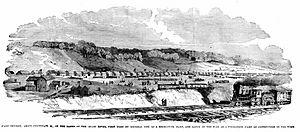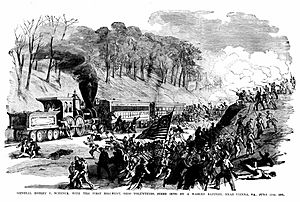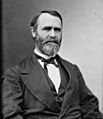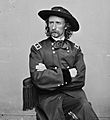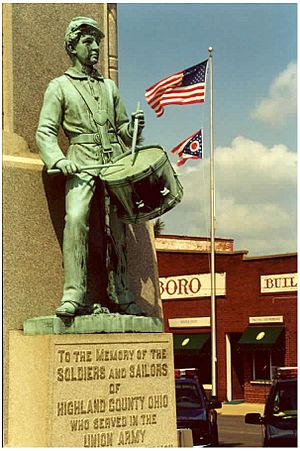Ohio in the American Civil War facts for kids
Ohio played a very important part in the American Civil War (1861-1865). It helped the Union Army by providing many soldiers, skilled military leaders, and supplies. Because of its location in the Northern United States and its growing population, Ohio was key to the war effort.
Even though Ohio had strong Republican politicians, the state was also divided. Some parts of southern Ohio supported the "Peace Democrats," who were against President Abraham Lincoln's plans. Before the war, Ohio was a major stop on the Underground Railroad. It continued to be a safe place for people escaping slavery during the war.
Ohio was the third largest state in the Union by population. It sent almost 320,000 soldiers to fight for the Union. This was the third highest number of soldiers from any state, after New York and Pennsylvania. Ohio also had the highest percentage of its people serving in the military. Many important generals came from Ohio, including Ulysses S. Grant, William T. Sherman, and Philip H. Sheridan. Five future Presidents of the United States were also Civil War officers from Ohio. The Fighting McCooks were a famous family with many officers in the U.S. Army.
Ohio was mostly safe from the war's destruction. Only two small battles happened within its borders. Morgan's Raid in 1863 caused fear but not much damage. Ohio troops fought in almost every major battle of the war. About 7,000 Ohio soldiers died in action. A very important Civil War site in Ohio is Johnson's Island. It was a prison camp for Confederate officers in Sandusky Bay. Over 15,000 Confederate soldiers were held there during the war. About 300 of them are buried in the island's cemetery.
Contents
Ohio's Role in the Civil War
Ohio's Political Landscape During the War
Southern Ohio's economy relied on trade with the Southern United States across the Ohio River. This river had long connected Ohio with slave states like Virginia and Kentucky. The culture in southern Ohio was similar to these southern states. Many settlers came from the South, and the area was once part of Virginia.
Most people in Ohio were strongly against states leaving the Union. In the 1860 Presidential Election, Ohio voted for Abraham Lincoln. He received 52.3% of the votes in the state.
Several Ohioans held important jobs in Lincoln's government. Edwin M. Stanton from Steubenville, Ohio became the Secretary of War. Former Ohio Senator and Governor Salmon P. Chase became the Secretary of the Treasury. Important Ohio politicians in Congress included Senators John Sherman and Benjamin F. Wade.
Three men served as Governor of Ohio during the war. They were William Dennison, David Tod, and John Brough. Governor Dennison sent Ohio troops to western Virginia without being asked. These troops guarded a meeting that led to West Virginia becoming a free state. Governor Tod was known as "the soldier's friend." He worked hard to get supplies for Ohio's troops. He also quickly called out the state's militia to fight Confederate raiders. Governor Brough strongly supported Lincoln's war efforts. He convinced other governors to raise "100-day regiments." These new troops helped free up experienced soldiers for General Ulysses S. Grant's campaigns.
The Copperhead Movement in Ohio
During the middle of the war, a group called the "Copperheads" gained support in Ohio. They were "Peace Democrats" who wanted to end the war. A main leader was Congressman Clement Vallandigham. He believed in states' rights.
In 1863, General Ambrose E. Burnside warned that supporting the enemy would not be allowed. Vallandigham then gave a speech saying the war was not about saving the Union. He claimed it was to free Black people and "enslave" white people. Burnside arrested Vallandigham and took him to Cincinnati for trial. Vallandigham was found guilty and sentenced to prison.
President Lincoln changed Vallandigham's sentence. He sent him to the South, warning that he would be imprisoned if he returned north. Vallandigham then went to Canada. From there, he ran for governor against Brough in 1863 but lost. His campaign caused strong disagreements in Ohio.
Ohio's Support for Lincoln in 1864
Public opinion in Ohio changed to support President Lincoln more. This was especially true as Ohio generals became famous for their military wins. These victories included the Atlanta Campaign, the Siege of Petersburg, and Sheridan's Valley Campaigns.
In the 1864 Presidential Election, Ohio strongly supported Lincoln's reelection. The state gave him 56.4% of the votes. Lincoln traveled through Ohio by train for his inauguration. He made short stops in many cities. His first official speech after being elected was in Hudson, Ohio. Lincoln had visited Ohio before the war, but he did not return during the war. In 1865, his funeral train carried his body through the state on its way to Springfield, Illinois.
Newspapers in Ohio had lively discussions about the war. They shared views from Republicans, War Democrats, and Copperheads.
Ohio's Military Recruitment Efforts
When the Civil War began in 1861, President Lincoln asked for soldiers. Ohio quickly raised 23 volunteer infantry regiments for three months of service. This was 10 more regiments than the state was asked for. When it became clear the war would last longer, Ohio started raising regiments for three-year terms. At first, most soldiers were eager volunteers. Later, 8,750 men were drafted into service.
Almost 320,000 Ohioans served in the Union army. This was more than any other northern state except New York and Pennsylvania. Of these, 5,092 were free Black men. Ohio had the highest percentage of its population serving in the military. Sixty percent of all men aged 18 to 45 were in the service. Ohio formed 230 regiments of infantry and cavalry. It also had 26 light artillery batteries and 5 independent companies of sharpshooters.
About 35,475 Ohio soldiers were killed or wounded. This was more than 10% of all Ohioans who served. There were 6,835 men killed in action, including 402 officers.
Many small camps were set up across Ohio to train new regiments. Two large military posts were created: Camp Chase in Columbus, Ohio and Camp Dennison near Cincinnati. The 1st Regiment, Ohio Volunteer Infantry (OVI) was joined by over 100 more infantry regiments.
Ohioans first saw military action at the Battle of Philippi Races in June 1861. The 14th and 16th Ohio Infantry helped the Union win. Ohioans made up one-fifth of the Union army at the Battle of Shiloh in April 1862. There, 1,676 Ohio soldiers were killed or wounded. Ohio had its highest number of casualties at the Battle of Chickamauga in September 1863. There, 3,591 Ohioans were killed or wounded. Another 1,351 men were taken as prisoner of war by the Confederates. Among these prisoners, 36 men from the 2nd Ohio Infantry died in the terrible Andersonville prison. Hundreds more Ohio soldiers also died there.
Several Ohio regiments played key roles in other important battles. The 8th OVI helped stop Pickett's Charge at the Battle of Gettysburg. At the same battle, the 66th OVI helped protect Culp's Hill. George Nixon, the great-grandfather of President Richard Nixon, died at Gettysburg in the 73rd OVI.
John Clem became famous as "Johnny Shiloh" and "The Drummer Boy of Chickamauga." He was the youngest person to become a noncommissioned officer in United States Army history. More than 100 soldiers from Ohio units earned the Medal of Honor. Several received it for their bravery in the Great Locomotive Chase.
President Lincoln often asked how many Ohio men would be fighting before a battle. When asked why, Lincoln said, "Because I know that if there are many Ohio soldiers to be engaged, it is probable we will win the battle, for they can be relied upon in such an emergency."
Small disturbances happened in areas with many German and Irish immigrants. They also occurred along the Ohio River, where many Copperheads lived. Holmes County, Ohio was a quiet area with many German immigrants. It was a Democratic stronghold, and few people supported the draft. Local politicians spoke against Lincoln and Congress. They saw the draft as a violation of their local freedom. In June 1863, small disturbances broke out. They ended when the Army sent in armed units.
John A. Gillis, a corporal from the 64th Ohio Infantry, wrote in his diary why he fought for the Union. He said, "We are now fighting to destroy the cause of these dangerous diseases, which is slavery and the slave power."
Military Actions Within Ohio
Unlike its neighbors West Virginia, Kentucky, and Pennsylvania, Ohio did not see many serious military fights. In September 1862, Confederate forces under Brig. Gen. Henry Heth marched through northern Kentucky. They threatened Cincinnati (see Defense of Cincinnati). But they turned back after seeing strong Union defenses south of the Ohio River. Soon after, Brig. Gen. Albert G. Jenkins briefly entered the very southern tip of Ohio during a raid.
It was not until the summer of 1863 that a large Confederate force arrived. John Hunt Morgan's cavalry division rode through southern and eastern Ohio during Morgan's Raid. His actions ended with Morgan's capture in Columbiana County, Ohio at the Battle of Salineville. The Battle of Buffington Island was the biggest battle fought in Ohio during the Civil War.
Important Civil War Leaders from Ohio
Many important generals and army commanders came from Ohio. The main general of the Union armies, Ulysses S. Grant, was born in Clermont County, Ohio in 1822.
Among the 19 major generals from Ohio were William T. Sherman, Philip H. Sheridan, Don Carlos Buell, Jacob D. Cox, George Crook, George Armstrong Custer, James A. Garfield, Irvin McDowell, James B. McPherson, William S. Rosecrans, and Alexander M. McCook. The McCook family sent many generals into the service. Ohio also provided 53 brigadier generals.
A few Confederate generals were born in Ohio. These included Bushrod Johnson from Belmont County, Ohio and Robert H. Hatton from Steubenville, Ohio. Charles Clark of Cincinnati led a division in the Army of Mississippi. He later became the pro-Confederate Governor of Missouri. Famous Confederate guerrilla Captain William Quantrill was also born and raised in Ohio.
Besides Grant and Garfield, three other Ohio Civil War veterans became President of the United States after the war. They were William McKinley of Canton, Ohio, Rutherford B. Hayes of Fremont, Ohio, and Benjamin Harrison from the Cincinnati area.
-
Lt. Gen.
Ulysses S. Grant -
Maj. Gen.
William T. Sherman -
Maj. Gen.
Philip H. Sheridan -
Sec. of War
Edwin M. Stanton -
Sec. of Treasury/Chief Justice
Salmon P. Chase -
Maj. Gen.
James B. McPherson -
Maj. Gen.
Jacob D. Cox -
Maj. Gen.
James A. Garfield -
Maj. Gen.
Rutherford B. Hayes -
Maj. Gen.
William S. Rosecrans -
Maj. Gen.
George A. Custer -
Rep.
Clement Vallandigham -
Maj. Gen.
Don Carlos Buell -
Maj. Gen.
George Crook -
Maj. Gen.
Alexander M. McCook -
Rep.
John A. Bingham
Civil War Sites in Ohio
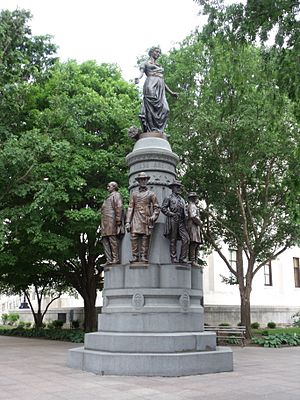
The most important battlefield in Ohio is Buffington Island. This was the site of the biggest fight during John Hunt Morgan's cavalry raid in July 1863. A smaller battle was the Battle of Salineville, where General Morgan was captured. He and some of his officers were held in the Ohio Penitentiary before escaping.
Ohio has two important cemeteries for soldiers from the Confederate States Army. One is at the prisoner-of-war camp on Johnson's Island. This was the most important Civil War site in the state, mainly for officers. Estimates say that 10,000 to 15,000 Confederate officers and soldiers were held there. About 300 Confederates died and were buried on the island. A museum about Johnson's Island is in Marblehead on the mainland. The Civil War buildings were taken down after the war. Another cemetery is at Camp Chase, where over 2,000 Southerners were buried. Union Cemetery in Steubenville, Ohio, is where Civil War soldiers, including several generals and colonels from the "Fighting McCooks" family, are buried.
Monuments in Cincinnati and Mansfield, Ohio remember the hundreds of Ohio soldiers who died in the Sultana steamboat tragedy. These soldiers had been freed from Southern prisons like Cahaba and Andersonville. After the war, women's groups helped raise money to create these memorials.
Many Ohio counties have Civil War monuments, statues, and cannons. These often honor their contributions to the war. They are frequently found near county courthouses. The Ohio State Capitol has Civil War guns on its grounds. In downtown Cleveland's Public Square is the impressive Soldiers' and Sailors' Monument. Other large monuments are in Dayton, Ohio, Hamilton, Ohio, and Columbus, Ohio. A large statue of General Sheridan is in Somerset, Ohio. New Rumley, Ohio has a memorial to George Armstrong Custer. Many Ohio Historical Markers across the state remember places and people from the Civil War.
Some homes of famous Civil War officers and political leaders have been restored. They are now open to the public as museums. These include the Daniel McCook House in Carrollton, Ohio. The Rutherford B. Hayes Presidential Center and Library in Fremont, Ohio has many Civil War items related to General Hayes. Similarly, "Lawnfield," the home of James A. Garfield in Mentor, Ohio, has a collection of Civil War items.
The Ohio History Connection keeps many war records, including artifacts and battle flags from regiments. More items can be found in the Western Reserve Historical Society's museum in Cleveland.
Civil War Prisons in Ohio
Camp Chase Prison was a Union Army prison in Columbus. In 1863, prisoners planned to revolt and escape. They hoped for help from Copperheads and Vallandigham, but the revolt never happened.


